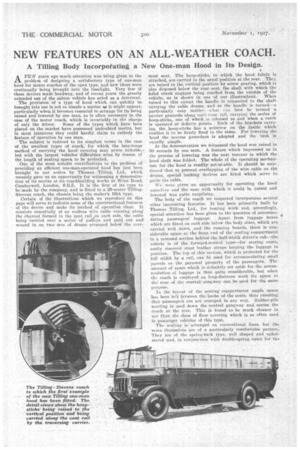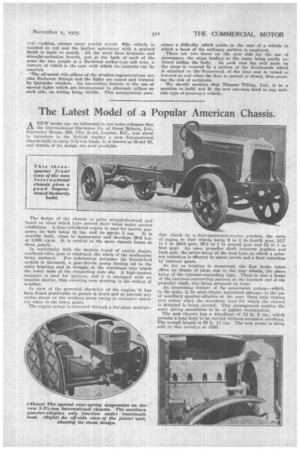NEW FEATURES ON AN ALL-WEATHER COACH.
Page 48

Page 49

If you've noticed an error in this article please click here to report it so we can fix it.
A Tilling Body Incorpotating a. New One-man Hood in Its Design.
A FEW years ago much attention was being given to the problem of designing a satisfaetory type of one-man hood for motor coaches of the open type, and new ideas were continually being brought into the limelight. Very few of these devices made headway, and of recent years. the greatly extended use of the saloon vehicle has acted as a deterrent.
The provision of a type of hood which can quickly be brought into use is not so simple a matter as it might appear, particularly when it becomes essential to arrange for its being raised and lowered by one man, as is often necessary in the case of the motor coach, which is invariably in the charge of only the driver. Some of the types which have been placed on the ,market have possessed undoubted merits, but in most instances they could hardly claim to embody the feature of .operation by one man.
The subject is reduced to its simplest terms in the case of the smallest types of coach, for which the lazy-tongs method of carrying the hood: covering may prove suitable,• but with the largest vehicles difficulties arise by reason of the length of seating space to be protected. One of the most notable contributions to the problem of providing an efficient one-man-operated hood has lust been brought to our notice by Thomas Titling, Ltd., which recently gave us an opportnnity for witnessing a demonstration of its merits at its coachbuilding works at Wren Road, Camberwell, L.Ondon, S.E..5. It is the first of its type to be. made by the company, and is fitted to a 29-seater TillingStevens coach, the chassis being the maker's B9Astype..
Certain of the illustrations which we reproduce on this page will serve to indicate some of the constructional features of the device and make its method of operation clear. It consists essentially of an endless wire cable running along the channel formed in the cant rail on each side, the cable being carried over a series of pulleys and paid out and wound in on two. Sets of drums arrauged below the rear:
most seat. The hoop-sticks, to which the hood fabric is attached, are carried in the usual position at the rear. They are raised to the vertical position by screw gearing, which is also disposed below the rear seat, the shaft with which the ha'nd crank engages being reached from the outside of the
vehicle, as is shown in one .-of our illustrationR. When raised to this extent the handle is connected to the shaft carrying the cable drums, and as the handle is turned—a particularly easy matter—what can best be termed a carrier proceeds along each cent rail, carrying the series of hoop-sticks, one of which is released as and when a catch is operated at definite points. Each of the brackets carrying the hoop-sticks has a setscrew on the inside which enables it to be firmly fixed to the sides. For lowering the hood the reverse procedure is adopted and the task is equally simple.
At the demonstration we witnessed the hood was raised in 50 seconds by one man. A feature which impressed us in the process of lowering was the neat manner in which the hood cloth was folded. The whole of the operating mechanism for the hood is readily get-at-able. It should he mentioned that to prevent overlapping of the wire cable on tilt drums, special 'rocking devices are fitted which serve to guide the cable.
We were given an onpoitunity for operating the hood ourselves and the ease with which it could be raised and lowered was quite surprising.
The body of the coach we inspected incorporates several other interesting features. It has been primarily built by Thomas Tilling, Ltd., for touring work and, accordingly, special attention has been given to the question of accommodating passengers' luggage. Apart from luggage boxes which are fitted on-each side b'elow the body sides, which are carried well down, and the running boards, there is considerable space at tbe front end of the seating compartment in a recessed section behind the half-width driver's cab—the vehicle is of the forward-control type—for storing eases, easily removed stout leather straps keeping the luggage in position. The top of this section, which is protected for the full width by -a rail, can be used for accommodating amen parcels or the personal property of the passengers. The amount of space which is definitely set aside for the accommodation. of luggage is thus quite considerable, but when th3 coach is employed on long-distance work the 'space to the rear of the central gangway can be used for the same Purpose.
In the layout of the seating compartment ample space has been loft between the backs of the seats, thus ensuring that passengerS are not cramped in any way. Rubber-pile matting is used down the central gangway and across' the coach at the rear. This is 'found to be much cleaner in use than the class of floor covering which is so often used it passenger vehicles of this type. The seating is arranged on conventional .lines, but the seats themselves are of a -particularly comfortable -pattern. They Are of the spring-back type, well shaped and upholstered 'and, in conjunction with double-spring eaSeS for the seat eushi-on, ensure most restful travel. 4The vehicle is finished in red and the leather upholstery -with a grained guildi is made to match. All the Eieats have footrests and dratight-exelusion hoards, and at the back of each of the "stilts for two people is a 13eclawat socket-type -ash tray, 11 feature of Which is the ease with which its contents can be emptied.
The all-metal side pillars of the window _superstructure are also Beelawat fittings and the fights are avised and lowered by Quicktho winders. As interesting feature is the use of special lights which are incorporated in alternate pillars on eswit _side, no wiring being visible_ This arrangement over
comes a difficulty which exists in the case of a vehicle in which a hood of the ordinary pattern is employed.
There are two doors on the near side for the use of pass*ngers the steps leading to the seats being partlyenclosed within the body. In each case the well made by the steps is covered by a section of the floorboards which is attached to the'framework of the door and is raised or lowered as and when the door is opened or closed, thus avoiding the risk of accidents. •
We rthould mention that Thomas Tilling, Ltd., is in a position to build and fit the new one-man hood to any suitable type of passenger vehicle.




































































































